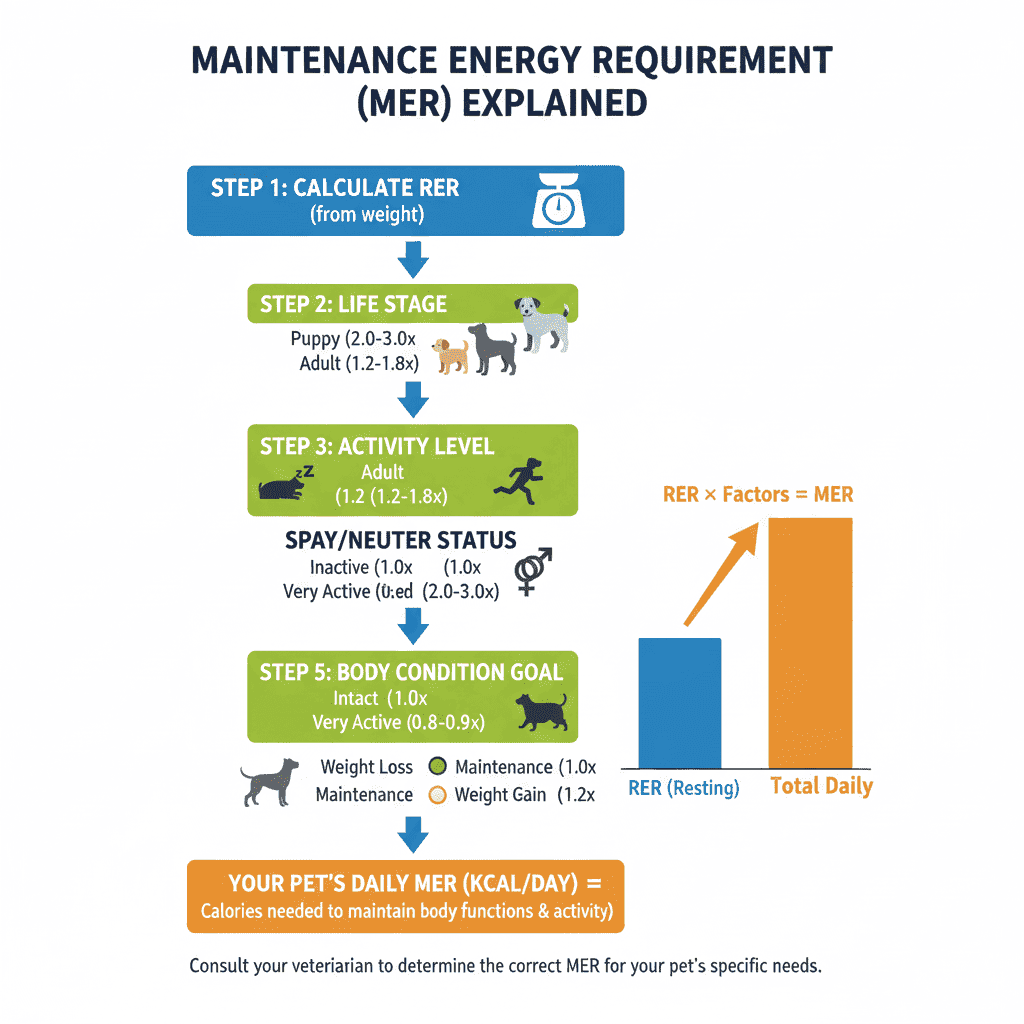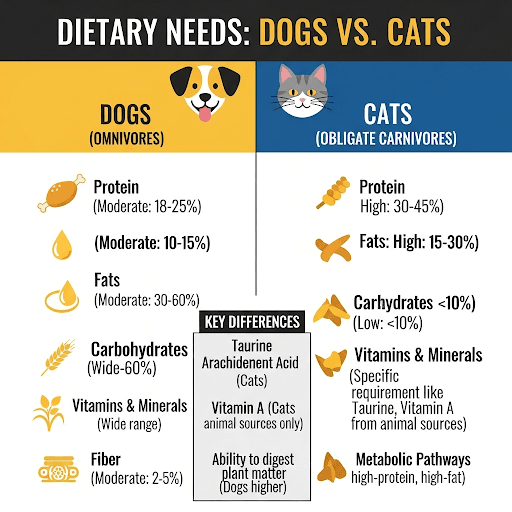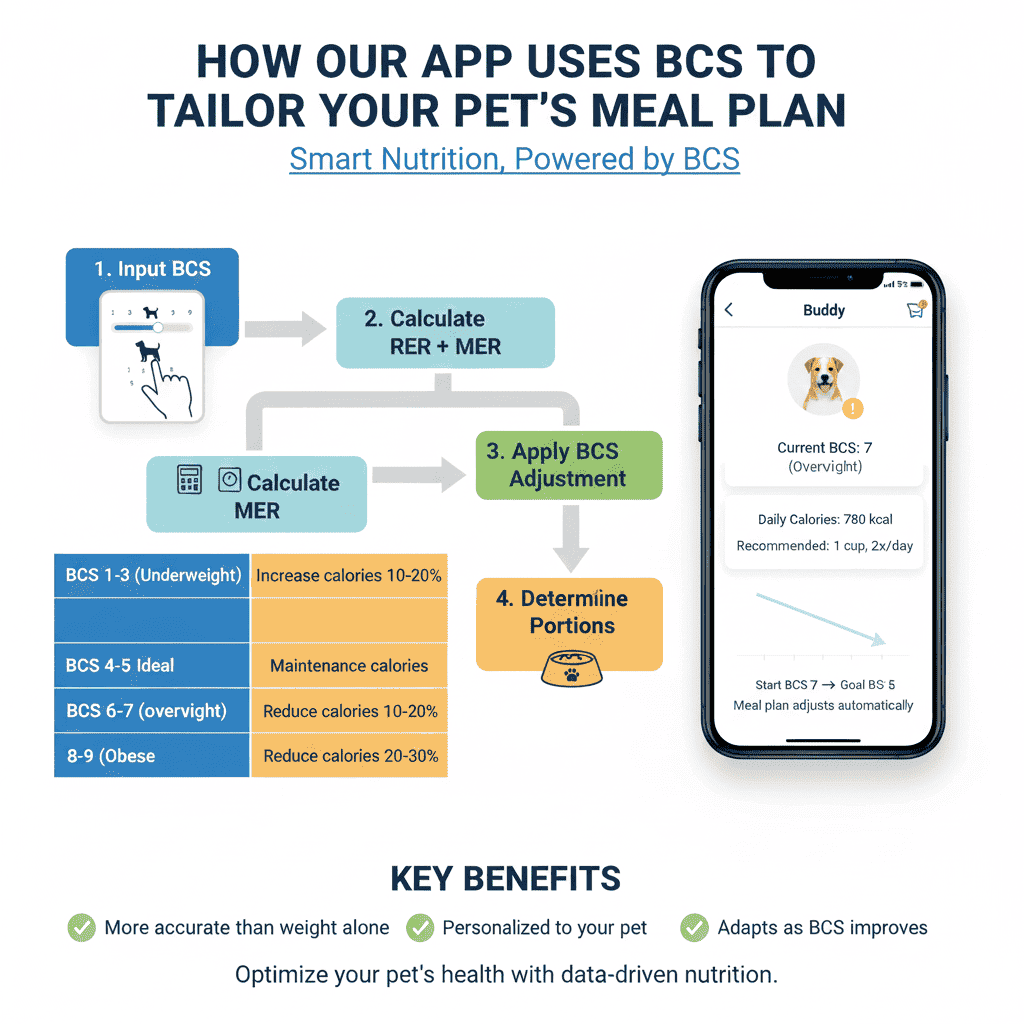Every living creature needs energy to survive—to breathe, to pump blood, to maintain body temperature, to think. Even when your pet is completely at rest, their body is working hard, burning calories to keep the essential systems running.
This baseline energy requirement has a name: RER, or Resting Energy Requirement. It's the foundation of all pet nutrition calculations, the starting point that tells you the absolute minimum number of calories your pet needs each day just to stay alive.
Understanding RER is like understanding the foundation of a house—you can't build anything solid without it. Whether you're trying to help your pet lose weight, gain weight, or maintain their ideal condition, RER is where every calculation begins.
What is RER?
Resting Energy Requirement (RER) is the number of calories your pet needs in a 24-hour period to maintain basic bodily functions while at complete rest in a thermoneutral environment (not too hot, not too cold).
Think of RER as your pet's "idle mode" energy consumption—like a car's engine running in park. Even though the car isn't moving, the engine is still burning fuel to keep running. Similarly, your pet's body is constantly burning calories for:
- Breathing: The muscles of respiration never stop working
- Circulation: The heart pumps blood continuously
- Brain function: The brain uses significant energy even during sleep
- Cell maintenance: Cells are constantly repairing and replacing themselves
- Digestion: The digestive system processes food (even when resting)
- Temperature regulation: The body maintains its core temperature
RER represents the energy needed for these essential functions—nothing more, nothing less. It doesn't account for:
- Physical activity
- Growth (for puppies and kittens)
- Pregnancy or lactation
- Illness or recovery
- Environmental stress
- Digestion of food (though this is minimal at rest)

The RER Formula: The Science Behind the Numbers
Veterinary nutritionists have developed a precise formula to calculate RER based on decades of research. The formula accounts for the fact that metabolic rate doesn't increase linearly with body weight—larger animals have a lower metabolic rate per unit of body weight than smaller animals.
The Standard RER Formula
RER = 70 × (body weight in kg)^0.75
This formula uses:
- 70: A constant derived from metabolic studies
- Weight in kilograms: Your pet's current body weight
- 0.75: The metabolic scaling exponent (this accounts for the non-linear relationship between size and metabolism)
Why This Formula Works
The 0.75 exponent is crucial because it reflects a biological reality: larger animals don't need proportionally more calories than smaller animals. For example:
- A 10 kg dog doesn't need 10 times the calories of a 1 kg dog
- A 5 kg cat doesn't need 5 times the calories of a 1 kg cat
Instead, the relationship follows a power curve, which is why the formula uses an exponent rather than simple multiplication.
Converting Weight to Kilograms
If your pet's weight is in pounds, you'll need to convert to kilograms first:
Weight in kg = Weight in pounds ÷ 2.2046
Or simply: Weight in kg ≈ Weight in pounds × 0.4536
Example Calculations
Example 1: A 20-pound dog
- Convert to kg: 20 lbs ÷ 2.2046 = 9.07 kg
- Calculate: RER = 70 × (9.07)^0.75
- Calculate: RER = 70 × 5.48
- RER = 384 calories per day
Example 2: A 10-pound cat
- Convert to kg: 10 lbs ÷ 2.2046 = 4.54 kg
- Calculate: RER = 70 × (4.54)^0.75
- Calculate: RER = 70 × 3.38
- RER = 237 calories per day
What RER Tells You (And What It Doesn't)
What RER Represents
RER tells you the absolute minimum calories your pet needs. This is useful for:
- Understanding baseline metabolism
- Calculating maintenance needs (when multiplied by activity factors)
- Determining minimum safe intake during weight loss
- Emergency feeding calculations
- Critical care nutrition
What RER Doesn't Account For
RER is just the starting point. It doesn't include:
- Activity: A dog that runs 5 miles a day needs far more than RER
- Life stage: Growing puppies and kittens need 2-3 times RER
- Reproductive status: Pregnant or nursing pets need significantly more
- Health status: Illness, recovery, or stress increase needs
- Environmental factors: Extreme heat or cold require extra energy
- Digestive efficiency: Different foods have different digestibility
This is why RER is always multiplied by various factors to get the actual daily calorie needs (called MER, or Maintenance Energy Requirement).
RER vs. Daily Calorie Needs
It's crucial to understand that RER is not the same as your pet's daily calorie needs. RER is the foundation, but your pet's actual requirements are typically 1.2 to 3.0 times RER, depending on:
- Activity level: Sedentary pets need less; active pets need more
- Life stage: Puppies/kittens need 2-3× RER; adults need 1.2-1.8× RER
- Spay/neuter status: Sterilized pets typically need 10-30% fewer calories
- Body condition: Overweight pets need less; underweight pets need more
- Health status: Illness, recovery, or stress can increase needs
The actual daily calorie requirement (MER) is calculated by multiplying RER by these various factors.
Why RER Matters for Your Pet
1. Foundation for All Calculations
Every pet nutrition calculation starts with RER. Whether you're:
- Planning a weight loss program
- Feeding a growing puppy
- Managing a senior pet's diet
- Calculating portions for a new food
RER is the starting point that ensures accuracy.
2. Safety in Weight Loss
When helping your pet lose weight, you should never feed below RER (except under strict veterinary supervision in medical cases). RER represents the minimum needed for basic survival. Feeding below RER can cause:
- Muscle loss
- Organ damage
- Metabolic problems
- Serious health complications
3. Understanding Your Pet's Metabolism
RER helps you understand your pet's baseline metabolism. Two pets of the same weight can have different RER values if their body composition differs (more muscle = higher RER), but the formula gives you a reliable starting point.
4. Precision in Meal Planning
Accurate RER calculation leads to precise meal planning. When you know your pet's RER, you can:
- Calculate exact portions
- Choose appropriate foods
- Track progress accurately
- Make informed adjustments
Factors That Don't Change RER (But Affect Total Needs)
These factors don't change the RER calculation itself, but they affect how much you multiply RER to get daily needs:
Age
- Puppies/Kittens: Need 2-3× RER for growth
- Adults: Need 1.2-1.8× RER for maintenance
- Seniors: May need 1.0-1.4× RER (less active, slower metabolism)
Activity Level
- Inactive/Sedentary: 1.0-1.2× RER
- Low Activity: 1.2-1.4× RER
- Moderate Activity: 1.4-1.6× RER
- High Activity: 1.6-2.0× RER
- Very Active/Working: 2.0-3.0× RER
Spay/Neuter Status
- Intact: Higher metabolic rate
- Spayed/Neutered: 10-30% reduction in total needs (not RER itself, but the multiplier)
Body Condition
- Ideal Weight: Standard multipliers apply
- Overweight: Reduce by 10-20% for weight loss
- Underweight: Increase by 10-20% for weight gain
Common Misconceptions About RER
Misconception 1: "RER is how many calories my pet needs"
Reality: RER is the minimum for basic survival. Your pet needs more than RER for normal daily life.
Misconception 2: "I can use RER to feed my active dog"
Reality: An active dog needs 1.5-2.5× RER. Feeding only RER would cause weight loss and health problems.
Misconception 3: "RER is the same for all pets of the same weight"
Reality: While the formula is the same, individual pets have variations. RER is a starting point, not an absolute.
Misconception 4: "I should feed my pet exactly RER"
Reality: You should feed based on MER (Maintenance Energy Requirement), which is RER multiplied by appropriate factors.
How Our App Uses RER
At PetMealPlanner, RER is the foundation of every calculation:
- We calculate RER first using your pet's weight
- We apply life stage multipliers (puppy, adult, senior)
- We adjust for activity level (inactive to very active)
- We account for spay/neuter status (reduced needs for sterilized pets)
- We factor in body condition (weight loss, maintenance, or gain goals)
- We calculate MER (the actual daily calorie target)
- We determine portions based on your chosen food's calorie content
This multi-step process ensures your pet gets precisely the right amount of food for their unique needs.
When to Recalculate RER
Recalculate RER when:
- Your pet's weight changes significantly (gain or loss of 5% or more)
- You're starting a new diet plan
- Your pet's life stage changes (puppy to adult, adult to senior)
- Health status changes (illness, recovery, surgery)
- Activity level changes significantly
For most pets, recalculating every 3-6 months is sufficient, unless they're on an active weight management program (then monthly is better).
The Bottom Line
RER (Resting Energy Requirement) is the scientific foundation of pet nutrition. It represents the minimum calories your pet needs for basic survival—the energy required to keep their heart beating, their lungs breathing, and their brain functioning.
Understanding RER helps you:
- Make informed feeding decisions
- Plan safe weight loss programs
- Calculate precise portions
- Understand your pet's metabolism
But remember: RER is just the starting point. Your pet's actual daily needs (MER) are calculated by multiplying RER by factors for activity, life stage, and health status.
Ready to calculate your pet's RER and create a personalized meal plan? Use our pet meal planner to get started. Our system automatically calculates RER and applies all the necessary factors to determine your pet's precise daily calorie needs.
For more information on how RER is used to calculate your pet's total daily needs, see our article: MER Explained: Calculating Your Pet's True Daily Energy Needs.


